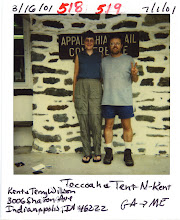Monday, May 11, 2009
Exhibits Committee Gives Go-Ahead for Show
Also, stop by the ATMS table under the big ATC tent to see a slide show of the ATC's thru-hiker Polaroids that were scanned earlier this year in preparation for a social networking site that will launch later this year. Sixteen volunteers put in 425 hours scanning 12,779 photographs! Here's the schedule:
Friday
10 a.m. 1979-1985; 2001
11 a.m. 1986-1988; 2002
12 p.m. 1989-1991; 2003
1 p.m. 1992-1994; 2004
2 p.m. 1995-1996; 2005
3 p.m. 1997-1998; 2006
4 p.m. 1999; 2007
5 p.m. 2000; 2008
Saturday
9 a.m. 1992-1994; 2004
10 a.m. 1995-1996; 2005
11 a.m. 1997-1998; 2006
12 p.m. 1999; 2007
1 p.m. 2000; 2008
2 p.m. 1979-1985; 2001
3 p.m. 1986-1988; 2002
4 p.m. 1989-1991; 2003
See you there!
Tuesday, April 21, 2009
Hiker Trash '01 exhibition proposal
Exhibition Working title: Hiker Trash! - Thru-Hiker Subculture on the Appalachian Trail (note: I’m thinking about focusing the exhibit around the A.T. northbound class of 2001 – which is when Kent and I hiked – in which case we might want to include the year in the title, something like Hiker Trash ’01. 2011 would be ten-year anniversary)
Suggested dates
Opening Date: Spring 2011 (preferably March)
Closing Date: TBD
Exhibit Description
This information will help determine where and when a proposed exhibit can be worked into the exhibit schedule. It will also help the exhibit committee decide how much time and what personnel will be needed to mount the exhibit.
Briefly describe the proposed exhibit: This exhibit will consist of a mix of graphics, images, and artifacts relevant to the subculture of the Appalachian Trail Thru-Hiker. This subculture, with its unique stories, language, accepted practices and mores, grew out of a larger camping/recreational movement (with utopian “recuperative” overtones) from early in the twentieth century.
In 1948 Trail icon, Earl Shaffer, became the first person to hike the entire length of the Appalachian Trail in one season. Earl (who eventually came to be known within the Trail community as “Crazy One”), documented his hike in slides and with a journal; eventually publishing Walking with Spring, a book which nearly every thru-hiker is aware of. His historic hike was featured in the August 1949 issue of “The National Geographic Magazine.” (FYI, The Smithsonian Institute holds Earl’s archives (he was a prolific poet) and artifacts from his 1948 hike. An exhibit featuring the poetry he generated during his military service in WWII is currently in development and is scheduled to open later this year).
Earl’s book and the NGM article sparked the interest of a number of hikers, and a decade later several thru-hikes had been completed, including that of “Granny Gatewood,” the first solo female thru-hiker who recorded her first of three thru-hikes in 1955 at the age of 67. The number of individuals attempting to accomplish a thru-hike grew slowly through the sixties, into the seventies and beyond, spiking in 2000 when more hike completions were reported during that year than in the first 40 years combined.
Possible topics for inclusion within the exhibit:
Earl (Can’t talk about the Trail without mentioning Earl)
Trail names (Where do they come from and why do people take on these names – their Trail “avatars”)
Trail lingo defined (Why do subcultures develop their own “languages”)
Communicating on the Trail (journals, Trail registers, notes posted to trees)
Trail recreation (dealing with boredom, thru-hiker jokes, Trail-related festivals)
Town stops (getting from the Trail into the nearest town – and vice versa, interacting with the locals, bagging a place to stay, doing laundry, getting clean, EATING!)
Hiker “obsessions” (elevation maps/mileage, homemade alcohol stove construction, gear, post office schedules, The Weather Channel, water sources/giardia, EATING!)
What is the purpose of this exhibit? I think this is a wonderful opportunity for a collaborative venture between the Mathers Museum and the Appalachian Trail Museum Society to present an exhibition about a very interesting subculture that attracts participants from all over the world, and, yet, manages to remain a uniquely American experience.
Who is the intended audience for this exhibit? [School children? University students? The general public?] Many thru-hikers are either on their way into or taking a break from/coming out of a university setting, so I would assume a segment of our audience will be students (possibly a sub-group that we don’t normally reach with many of our other exhibits). Educational programming targeting school children should fit well with several of the topics to be covered. Scout groups and other youth groups would be a natural fit. The exhibit should also be marketed to regional hiking groups (I can supply contact information for these groups), to ATMS members and to other Trail-related groups.
Further explanation and/or general comments: I’m looking into the possibility of finding other venues for the exhibit to travel to after it debuts at the Mathers Museum. One possibility would be to include it as an exhibit in the Trail town of Millinocket, where the “Trail’s End Festival” is held every September. If we were to close the show at the Mathers in August (to coincide with the end of IU’s summer session), it could go to Maine afterwards. This would be appropriate because it would correspond with the arrival of the northbound hikers at Katahdin.
